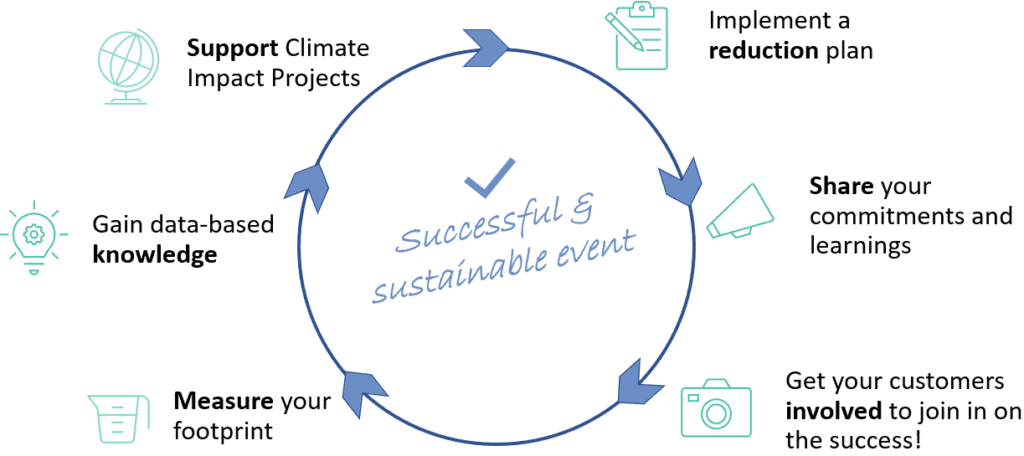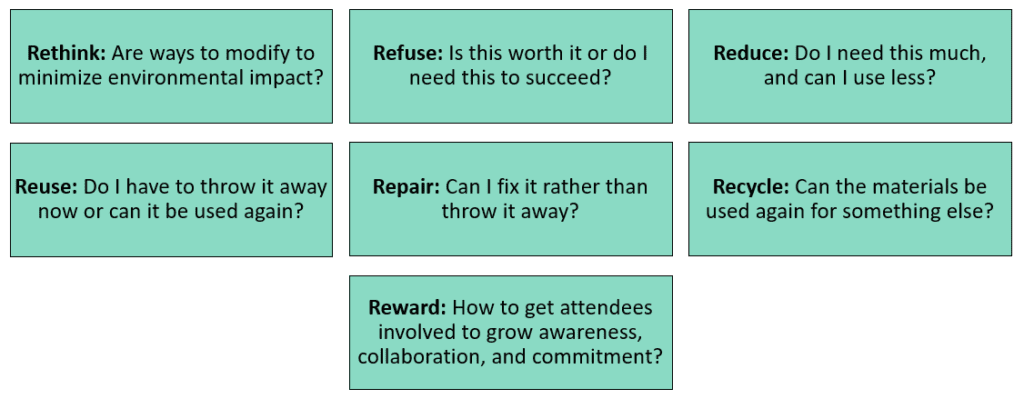Calculating Event Emissions to Take Sustainable Action

Tradewater was invited to share tools and resources for Event Tech Live attendees to help them produce more sustainable events. We were privileged to speak alongside some of the most knowledgeable in the event industry, including The Sustainable Events Forum and Curve.
Any event, whether it be a meeting, conference, workshop, concert, or baby shower, produces emissions. Emissions are carbon dioxide and other greenhouse gases that are released directly or indirectly into the atmosphere because of an activity. Event emissions are typically associated with attendee travel, hotel stays, energy usage, data storage, and production. The current climate crisis is a result of excess emissions caused by human activity. Therefore, it is important to understand and manage our emissions when possible. Event Carbon Calculators empower event organizers to measure their emissions, analyze the data, and take necessary action to offset and identify opportunities to reduce their footprint.
Calculating Event Emissions
Being “sustainable” is the ability to exist in a balance, meaning that we meet our current needs of the present without compromising the needs of the future. Just like it is beneficial for an event manager to track how they are prioritizing their time, it is beneficial to make informed decisions based on where your event’s emissions are coming from.
Tradewater’s Event Carbon Calculator provides a quick option for event leaders to calculate their carbon footprint for free. They simply enter the details of their event to get an estimated calculation of emissions generated by the event. The calculator typically takes about 15 to 30 minutes to complete and at the end of the process, organizers are given the option to offset emissions by supporting Tradewater’s climate solutions.
Support Climate Solutions to Offset Your Footprint
Offering a self-serve platform that is measurable, easy, cost-effective, and impactful, takes the guesswork out of climate action for event leaders and companies prioritizing sustainability. Vetting potential climate solutions is necessary to ensure your contributions are going towards impactful work. Tradewater is committed to providing the tools and verified solutions that enable everyone to take meaningful climate action. The climate solutions we are focused on meet and exceed the industry standards for quality, making them climate solutions that stakeholders can trust.
Whether you chose to support Tradewater, or another climate solution, there are a few things to consider when determining the quality of that solution:
- Permanent. Look for climate benefits that are permanent. Tradewater’s is forever destroying the greenhouse gases we collect, making the work permanent.
- Additional. Make sure the work would not happen if not for your support. For the gases Tradewater is collecting and destroying there is no end-of-life solution. If the work is not financially supported via the sale of carbon offset credits, it won’t be done.
- Accurate. Look for projects where the environmental impact is clear and can be measured accurately. One way to ensure this is to look for projects that are third-party verified and issued by the leading carbon registries, like ACR and VERRA. The carbon offset credits Tradewater creates are linked to an environmental benefit that is clear, measured, and precise. They are also third-party verified and listed on the leading carbon registries.
- Responsible. Select projects that are executed responsibly and have additional benefits. Fulfilling the UN Sustainable Development Goals (SDGs) are a good marker of co-benefits. Tradewater’s projects not only meet several SDGs, but also create economic benefits for local communities, having invested $32 million to date.
- Easy. Your interactions with solution providers should be easy and transparent. Tradewater is fully transparent with our documentation and provide ongoing support with a credit purchase, along with financing options, like a one-time payment or subscription.
Tradewater prides itself on satisfying all five of these considerations and is only able to complete our work through our collaborative partners and customers. Experts from Giving Green and Project Drawdown have found our credits to be of the highest quality and impact. As John Foley, Executive Director of Project Drawdown, said, “A Tradewater offset is an offset you can actually measure. This is a real thing that is tangible. You know how much you destroy and it’s preventing a real emission.”
Reduce Your Footprint and Enjoy the Co-Benefits
Mitigation tactics are simple, but they are not easy. The work must be continuous, in pursuit of progress over perfection. The top three emissions sources when it comes to events include food waste, transportation, and physical waste, like décor and swag. Use data to find ways to use less, waste less, and eliminate unforeseen surprises.

It’s important to clearly define the goals, objectives, and key performance indicators (KPIs) when crafting a carbon negative event from the beginning of the planning process.
Be intentional throughout the planning process by leveraging the Seven Rs of Sustainable Event Consumption:

Share Your Learnings & Success
As a bonus, weaving climate action into your event planning can achieve a multitude of co-benefits, influencing event stakeholders’ trust and loyalty. Attendees are expecting a valuable experience with sustainability in mind, sponsors need to uphold their own climate commitments, and the media wants shareable content. It is a personal and professional priority for everyone, and when the event efficiently executes these goals, it adds to everyone’s bottom line, including the planet’s.
When events are designed with the environment and inclusion at their heart, it demonstrates that a better way of doing things is attainable and rewarding. We have a huge opportunity to achieve positive change in the event industry and are well-positioned to move this movement forward. (Download)
Let’s show how it is done!

Event Tech Live presentation deck: Calculating Event Emissions to Take Sustainable Action.pptx
Sustainable Events Repo on GitHub (Open Sourced): https://github.com/jennymevents/sustainable-events
Sustainable Event Playbook Template Example (Open Sourced / Download): sustainable-events/Sustainable Event Playbook Template Example
Sustainable Event Playbook Template Checklist (Open Sourced / Download): sustainable-events/Sustainable Event Playbook Template Checklist
Event Emissions Calculator: Offset Your Event’s Carbon Footprint | Tradewater
Carbon Offset Recommendations: Recommendations | Where to Give | Giving Green
Carbon Labels: https://eventcellany.com/2021/03/01/what-if-conferences-came-with-a-carbon-label/
Sustainable Events Forum RFP Sustainability Questions: https://tsef.ca/resources
Curve’s Design and Host Brilliant Online Workshops https://www.closerapartbook.com